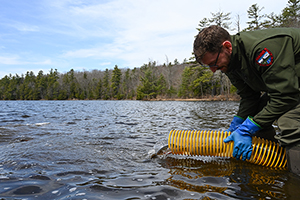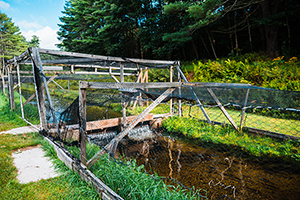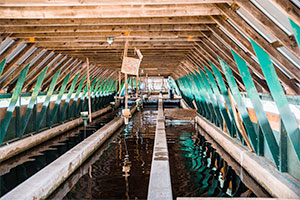Home → Fish & Wildlife → Hatcheries → Hatchery Improvements
Hatchery Improvements

Recognizing the economic importance of recreational fishing in Maine, Governor Mills has allocated $20 million for the redesign of two department hatcheries and water quality improvements at all state hatcheries through the Maine Jobs and Recovery Plan.
Fishing in Maine continues to grow in popularity and supports a recreational industry in Maine with an economic impact of over $320 million annually, supporting over 3,300 jobs. Many of these jobs are in rural areas, providing an economic boost where often there is little industry and few jobs. Over 380,000 anglers are licensed to fish in Maine annually, and these anglers pursue a variety of fish that include our coldwater species such as brook trout, brown trout, lake trout, and landlocked Atlantic salmon.
At the core of Maine’s fisheries is Maine’s state hatchery system, which stocks over one million fish annually into Maine’s waters. Maine’s hatcheries enhance fisheries where there is not enough natural fish reproduction to support a fishery; as well as sustains wild strains of brook trout, landlocked Atlantic salmon, and Arctic charr. During the Covid-19 pandemic, outdoor activities such as fishing spiked as people flocked to the outdoors. To sustain this recreational growth and continue to grow Maine’s outdoor economy, Maine’s hatcheries need to grow as well.
These Maine Jobs and Recovery funds will replace antiquated infrastructure at the 88-year-old New Gloucester Fish Hatchery, create needed capacity at Grand Lake Stream Hatchery to manage fish disease threats and conserve an endemic population of landlocked Atlantic salmon, and lastly improve the water quality leaving all eight fish culture facilities.
On this page:
- Grand Lake Stream Hatchery Upgrade Expansion
- Rebuild New Gloucester Fish Hatchery
- Improve Effluent at 8 Fish Culture Facilities
Grand Lake Stream Hatchery Upgrade Expansion

The Grand Lake Stream Hatchery produces 70% of the salmon stocked statewide.
Project Overview
Investments will safeguard one of the last remaining distinct landlocked Atlantic salmon populations while supplying our hatchery system with disease-free salmon. The installation of eight (20' diameter) circular tanks will isolate feral brood progeny fromproduction stocks of brook trout and a line of genetically represented back-up broodstock. Feral brood salmon eggs are collected each year from West Grand Lake wherethis endemic population is maintained by stocking due to loss of natural spawning habitat. This isolated system will allow for more additional fish health testing opportunities in response to a recent pathogen detection in feral fish without compromising the rest of the facility. A new bulk oxygen system will be installed to improve water quality along with an additional storage building. Increased fish production will result in an opportunity to raise more brook trout at this facility.Planned effluent treatment will address out wastewater discharge requirements.
Project Updates
July 2023: The Design process has been completed and the project is currently out to bid to contractors. The project will be awarded to a contractor following the August 24th bid deadline.
March 2023: Schematic Designs have been received from HDR and reviewed by MDIFW. Many meetings have occurred with multiple requests for design changes from MDIFW to accommodate workflow, site space constraints, and building design that meets the challenges of the Northeast climate.
Additional services were added to the New Gloucester and Grand Lake Stream scope for location of existing underground utilities. As the design has progressed it has become essential to document the exact utility locations to prevent any conflict during construction.
Additional services for Boundary survey have been added to the Grand Lake Stream scope. New infrastructure will be in close proximity to neighboring property and it is essential to obtain an exact location of property lines to avoid conflict during construction.
The Design Development Submittal’s for each location is anticipated to be received for review by MDIFW before the end of March 2023. HDR is currently pursuing permitting for both sites with a targeted “issued for bid” date for each site of May 30, 2023.
January 2023: Borings tests are scheduled to be completed at both the New Gloucester and Grand Lake Stream facilities mid-January. Next steps will include preliminary permitting meetings with Maine Department of Environmental Protection and Army Core of Engineers in unison with the creation of construction bid plan documents.
December and November 2022: Working on design solutions.
October 2022: Currently under contract for engineering and design.
Rebuild New Gloucester Fish Hatchery

All brown and rainbow trout produced by MDIFW’s hatchery system originate at this facility, which also produces 40% of the brown trout stocked in Maine.
Project Overview
The New Gloucester Fish Hatchery is the last state facility to use earthen raceways to raise fish. The raceways are original to the 1930s facility. The raceway banks are collapsing,and control damsare at risk of catastrophic failure. 25% of fish production is lost annually due to wildlife predation and are more susceptible to fish disease and pathogen threatsin this system. Proposed investments will ensure continued fish production, significantly improve the ability to remove phosphorus from effluent, manage fishpathogens, and reduce production losses. Planned investments include construction of 16 (20’ diameter) covered round tanks, a new bulk oxygenation systemto improve water quality, and dredging sediment from the inlet to eliminate sediment discharge into the hatchery.
Project Updates
July 2023: Design of the new hatchery facility and effluent upgrades are at 95% completion for the project. A pre-permit application meeting is scheduled for July 27th to be held with the Maine Department of Environmental Protection and Army Core of Engineers. It is anticipated the permitting process will last approximately 90 days allowing the project to go to bid to contractors in October of 2023.
March 2023: Schematic Designs have been received from HDR and reviewed by MDIFW. Many meetings have occurred with multiple requests for design changes from MDIFW to accommodate workflow, site space constraints, and building design that meets the challenges of the Northeast climate.
Additional services were added to the New Gloucester and Grand Lake Stream scope for location of existing underground utilities. As the design has progressed it has become essential to document the exact utility locations to prevent any conflict during construction.
Additional services for Boundary survey have been added to the Grand Lake Stream scope. New infrastructure will be in close proximity to neighboring property and it is essential to obtain an exact location of property lines to avoid conflict during construction.
The Design Development Submittal’s for each location is anticipated to be received for review by MDIFW before the end of March 2023. HDR is currently pursuing permitting for both sites with a targeted “issued for bid” date for each site of May 30, 2023.
January 2023: HDR Engineering has completed hydraulic profiles using Lidar data to conceptually locate placement of two pavilion buildings housing the circular tank farms at the New Gloucester facility. After a thorough review of the site and preferred placement of the pavilions, it was determined additional services including a Boundary survey and a Wetland Delineation Field Assessment would be required. The Wetland Delineation report and Topo & Boundary survey have been completed by the local firm Owen Haskel. Borings tests are scheduled to be completed at both the New Gloucester and Grand Lake Stream facilities mid-January. Next steps will include preliminary permitting meetings with Maine Department of Environmental Protection and Army Core of Engineers in unison with the creation of construction bid plan documents.
December and November 2022: Working on design solutions.
October 2022: Currently under contract for engineering and design.
Improve Fish Hatcheries & Effluents

Project Overview
Four of the eightexisting fish culture facilities have installed infrastructure to mechanically remove suspended solids (and associated phosphorus). Similarinvestments are needed at the remaining four facilities along with potential tertiary at all locations. Additional reductions in phosphorus will require use of muchmore refined and expensive technologies, including the likely use of chemicals to precipitate phosphorus. Additionally, more rigorous phosphorus standards arebeing proposed by Maine DEP that will require additional investments. The goal of these investments will be to maintain existing fish production of highquality, disease-free fish, as well as to improve and potentially introduce efficiencies and modernization of antiquated infrastructure to potentially increase fishproduction, and remain/obtain compliance with our wastewater discharge licenses
Project Updates
November 2023: Currently HDR is working multiple sites conducting survey and Geotech services to move forward with designs.
September 2023: HDR presented MDIFW with a 15% Schematic Design Submittal
July 2023: MDIFW issued a contract with HDR Engineering in July of 2023 for the amount of $951,035.00. At this time HDR provided a project construction cost estimate of $7,700,030.
October 2022: Pending engineering contract.